When Sarah transformed her stark studio apartment into a lush urban oasis using just $200 worth of plants and creative mounting solutions, her Instagram followers couldn’t stop asking for her secrets. You’ll discover how to maximize your space with strategic plant placement, from creating eye-catching living walls to designing functional green dividers. These ten practical hacks will show you how to blend nature with your existing décor while avoiding common mistakes that lead to plant casualties and design mishaps.
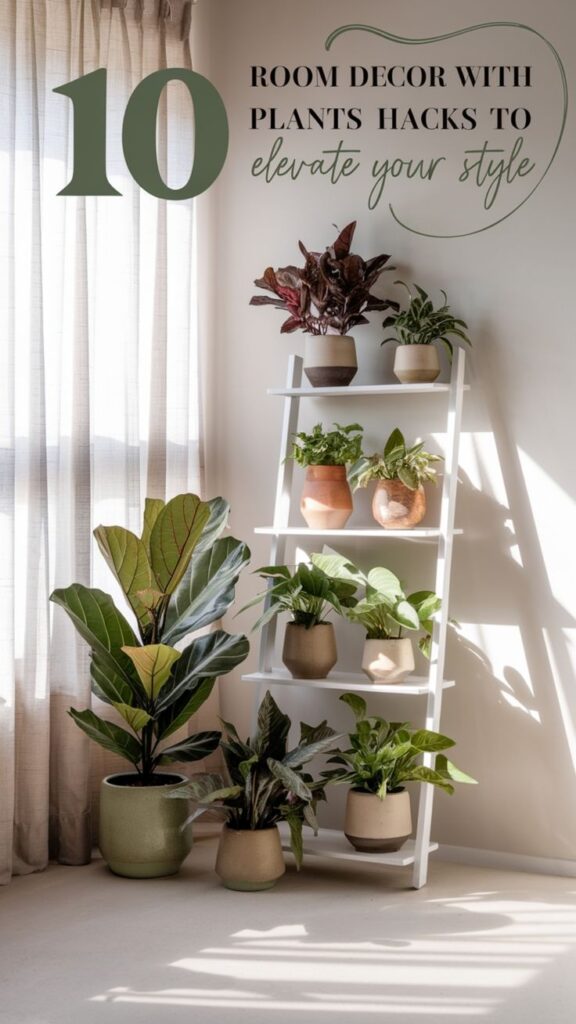
Contents
- 1 Create a Living Wall Using Pocket Planters
- 2 Design a Floating Plant Corner With Macramé Hangers
- 3 Transform Bookshelves Into Plant Display Stations
- 4 Build a Vertical Garden Using Repurposed Ladders
- 5 Style Window Frames With Trailing Plant Arrangements
- 6 Arrange Mini Plant Terrariums for Coffee Tables
- 7 Set Up a Plant-Based Room Divider
- 8 Craft a Hanging Herb Garden for Kitchen Spaces
- 9 Incorporate Plants Into Bathroom Décor
- 10 Design a Plant-Themed Workspace Oasis
Create a Living Wall Using Pocket Planters
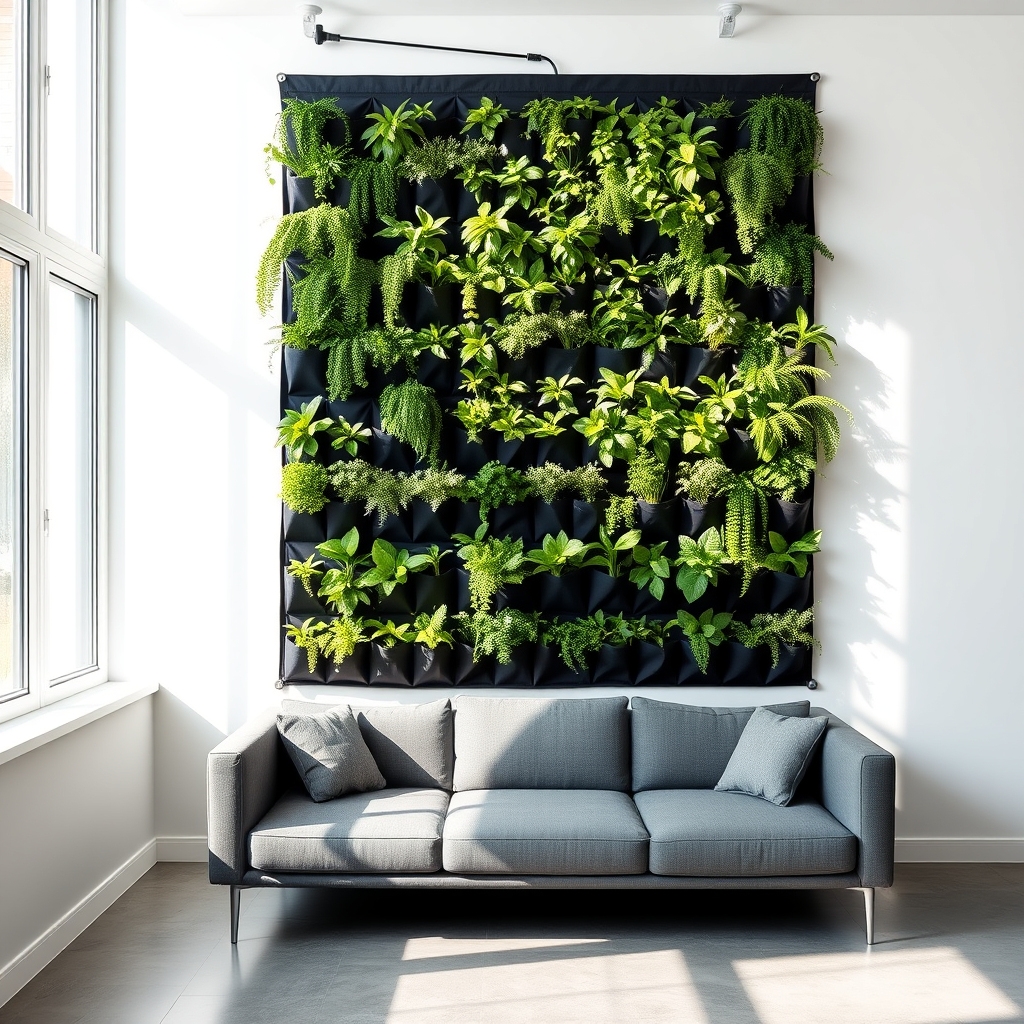
A living wall using pocket planters transforms vertical space into a lush, green tapestry of plants arranged in fabric or plastic pouches mounted on the wall.
The pocket planters are typically arranged in rows or patterns, creating a grid-like structure where various plants grow outward from individual compartments. This space-saving solution allows plants to cascade, climb, or grow upright, creating depth and visual interest.
The unique feature of pocket planters is their modular design, which makes it easy to replace individual plants and customize the arrangement according to light conditions and aesthetic preferences.
The system often includes a built-in irrigation method, either through self-watering mechanisms or manual watering from the top, allowing water to naturally flow downward through the connected pockets.
Design a Floating Plant Corner With Macramé Hangers
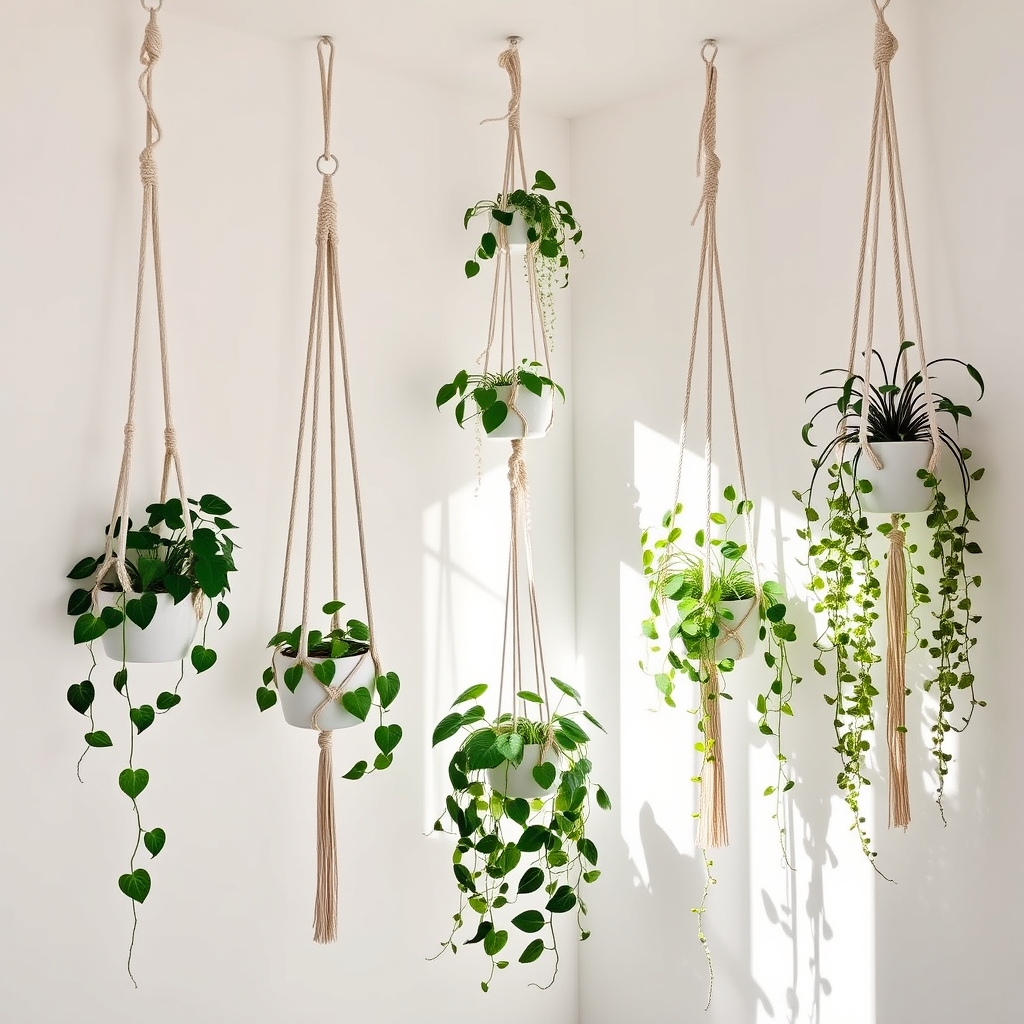
A floating plant corner with macramé hangers transforms unused vertical space into a stunning botanical display. Multiple macramé plant holders, crafted from knotted cotton cord in varying patterns, suspend plants at different heights from the ceiling or wall hooks.
The layered arrangement creates visual depth, while the woven designs add bohemian texture to the room. The hanging plants appear to float in mid-air, typically positioned in a corner where two walls meet.
Common placement options include pothos, spider plants, or string of pearls cascading from ceramic or terra cotta pots. The macramé holders range from simple single-plant designs to elaborate multi-tiered arrangements, often incorporating wooden beads or copper accents for additional style elements.
This corner feature maximizes space efficiency while drawing the eye upward, making rooms appear larger. The natural draping of trailing plants combined with the handcrafted macramé creates an organic, artistic focal point that brings life to previously underutilized corners.
Transform Bookshelves Into Plant Display Stations
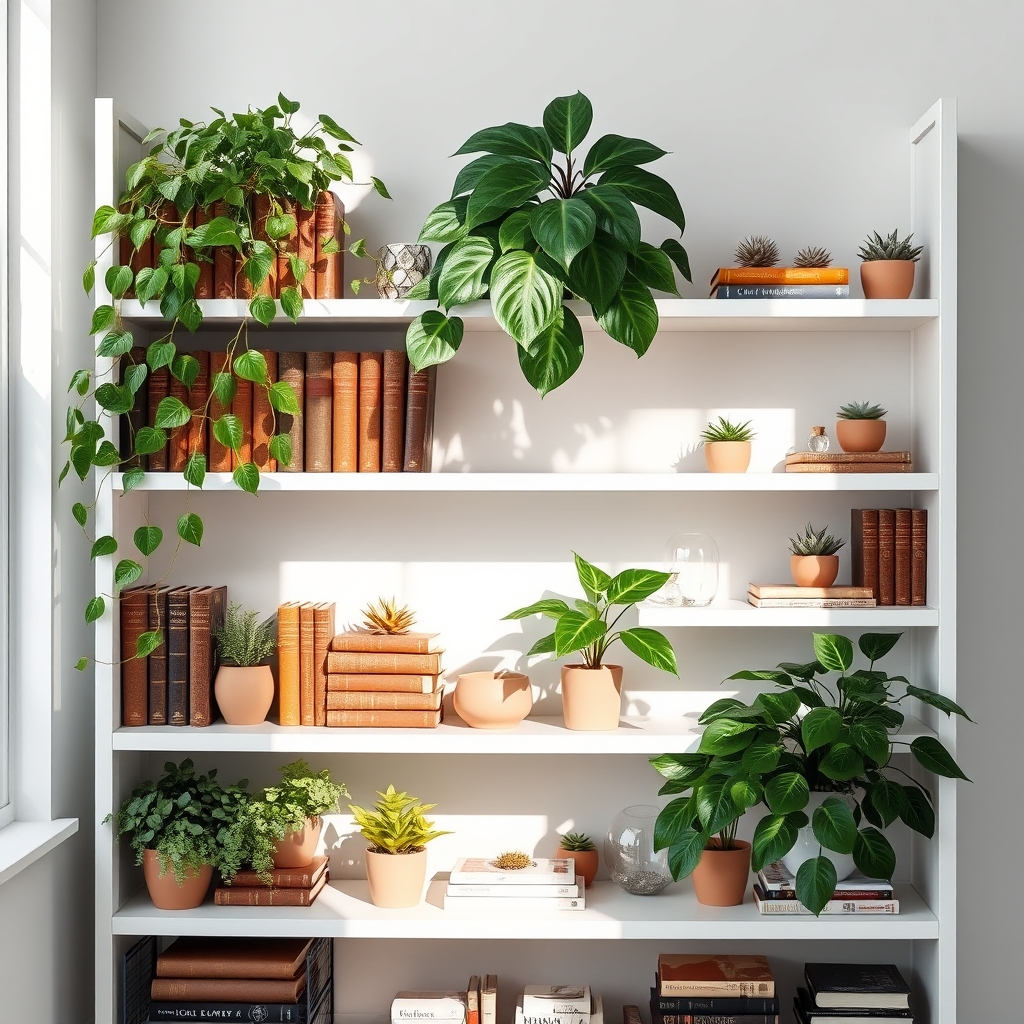
Transforming bookshelves into plant display stations creates a dynamic vertical garden by alternating books with potted plants on shelf levels.
The setup features plants of varying sizes and textures alongside reading materials, with trailing plants cascading down shelf edges and compact specimens nestled between book stacks.
This dual-purpose arrangement maximizes space while adding natural elements to the room’s decor.
Unique features include adjustable shelf heights to accommodate taller plants, the option to add grow lights under shelves for low-light areas, and the ability to create themed sections combining specific plant types with related books.
The versatile display allows for seasonal rotation of plants and easy maintenance access.
Build a Vertical Garden Using Repurposed Ladders
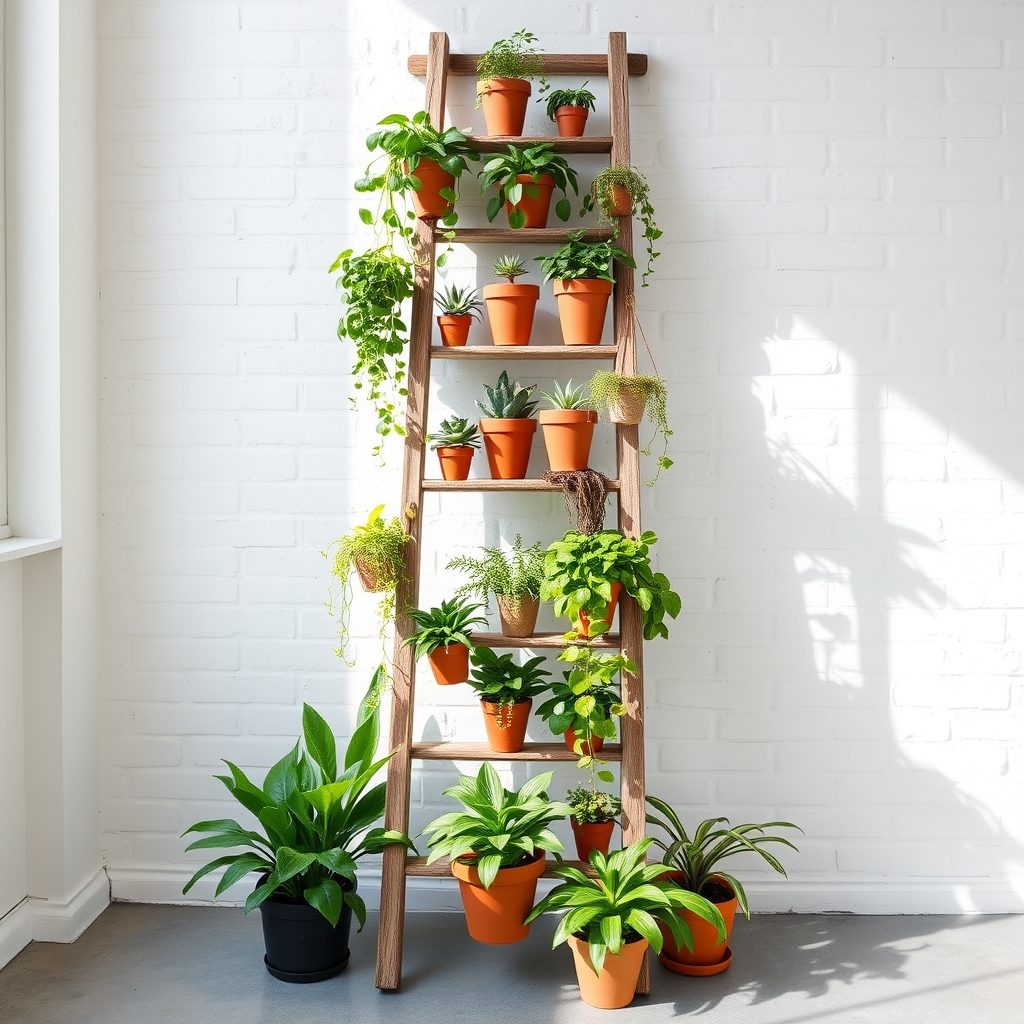
A vertical garden using repurposed ladders transforms an old wooden or metal ladder into a space-saving plant display.
The ladder’s steps serve as natural shelving tiers for potted plants, creating a triangular or wall-mounted garden structure. Plants can be arranged from top to bottom, with larger pots on lower rungs and smaller ones on upper levels.
The ladder can be painted or left rustic, and additional features like hanging planters or decorative pots can be attached to the sides.
This design works both indoors against walls and outdoors on patios, maximizing vertical space while adding a vintage, industrial, or farmhouse aesthetic to any room.
Style Window Frames With Trailing Plant Arrangements
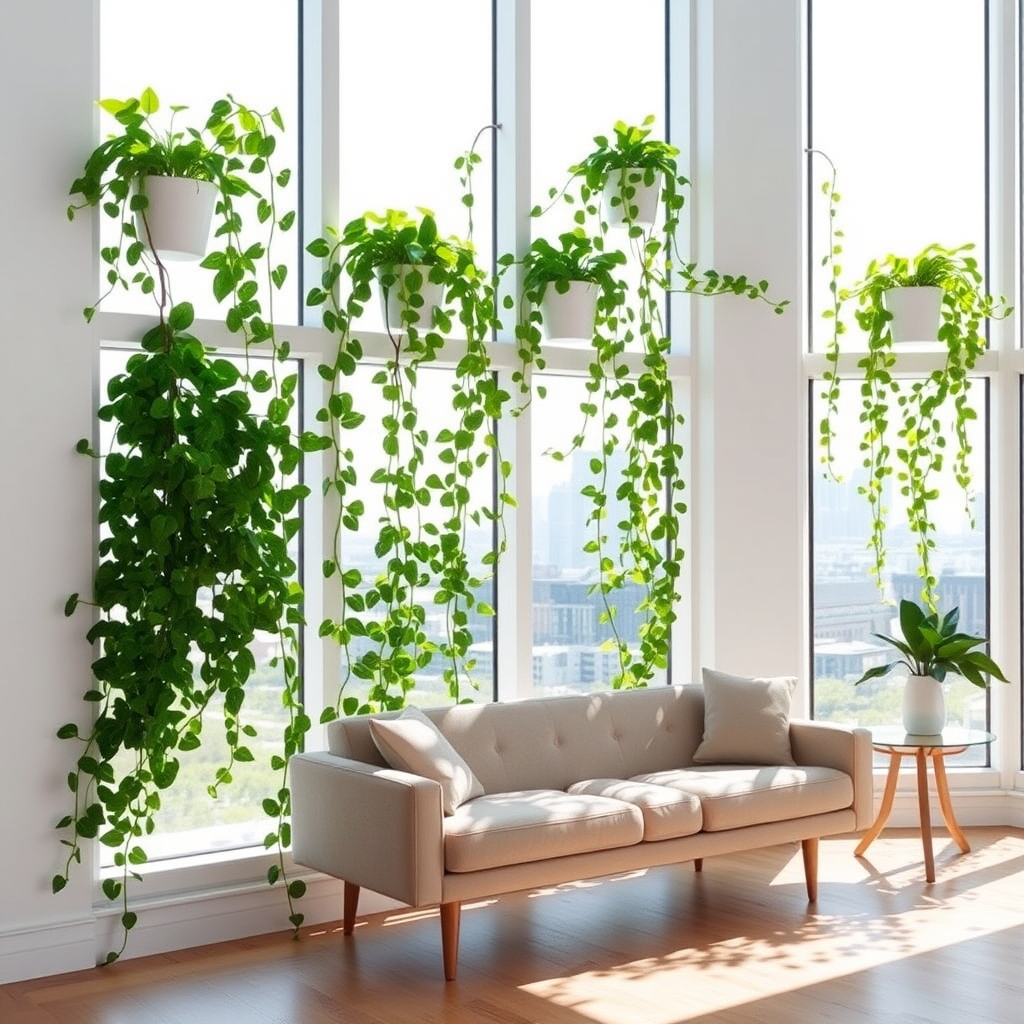
Trailing plant arrangements along window frames create cascading green curtains that soften architectural lines while maximizing natural light exposure.
Plants like pothos, ivy, or string of pearls are mounted in decorative containers along the upper window frame, allowing their vines to gracefully drape downward.
The arrangement frames the window view with living greenery, adding movement and organic shapes to the room’s design.
This vertical gardening technique saves floor space while drawing the eye upward, making rooms appear taller.
Window-mounted trailing plants benefit from direct light access and create an appealing indoor-outdoor connection, effectively blurring the boundary between interior and exterior spaces.
Arrange Mini Plant Terrariums for Coffee Tables
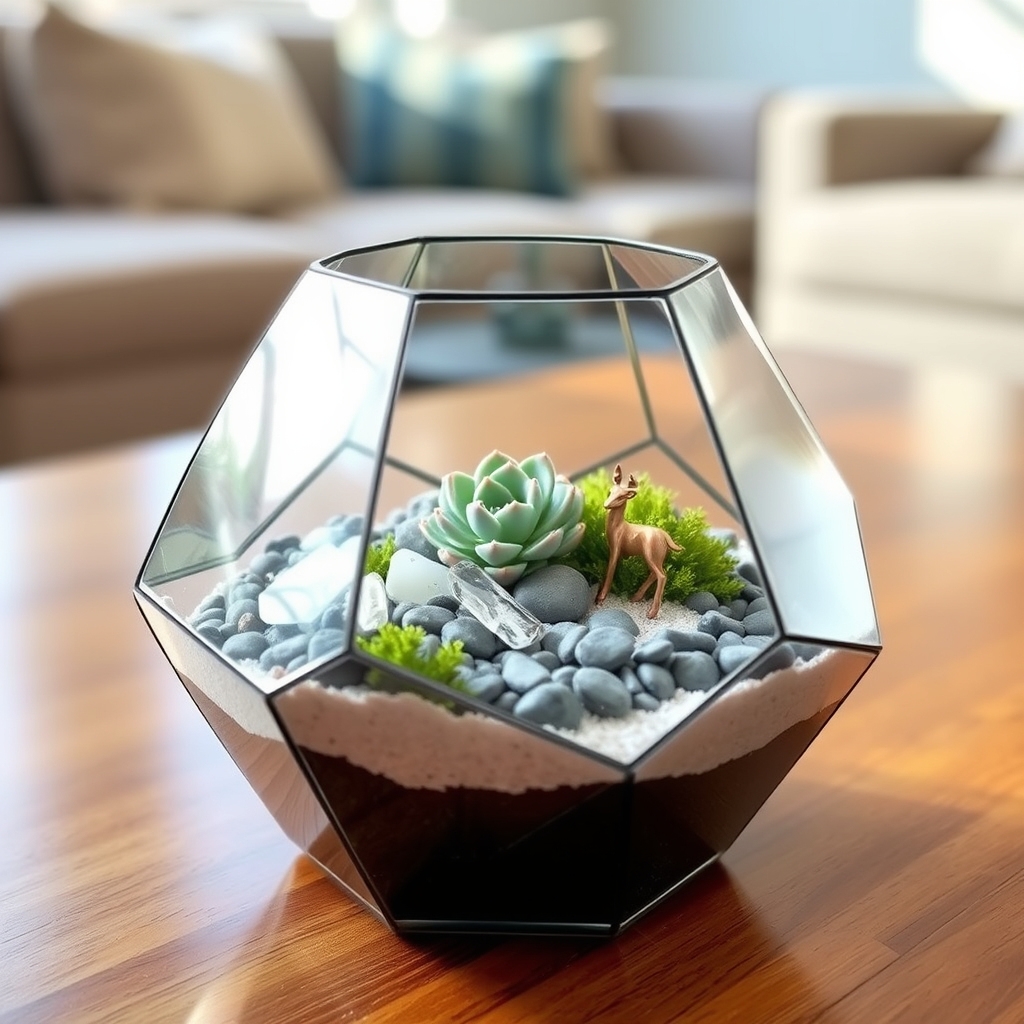
Mini plant terrariums for coffee tables create eye-catching displays using small glass containers filled with layers of soil, decorative stones, and compact plants.
These self-contained ecosystems typically feature succulents, air plants, or miniature ferns arranged with tiny decorative elements like colorful pebbles, moss, or small figurines.
The transparent containers allow viewers to see the intricate layers while providing a natural focal point that doesn’t overwhelm the coffee table space.
Each terrarium can be customized in size and style, from geometric glass vessels to vintage mason jars, making them versatile decorative pieces that add life to any coffee table arrangement.
Set Up a Plant-Based Room Divider
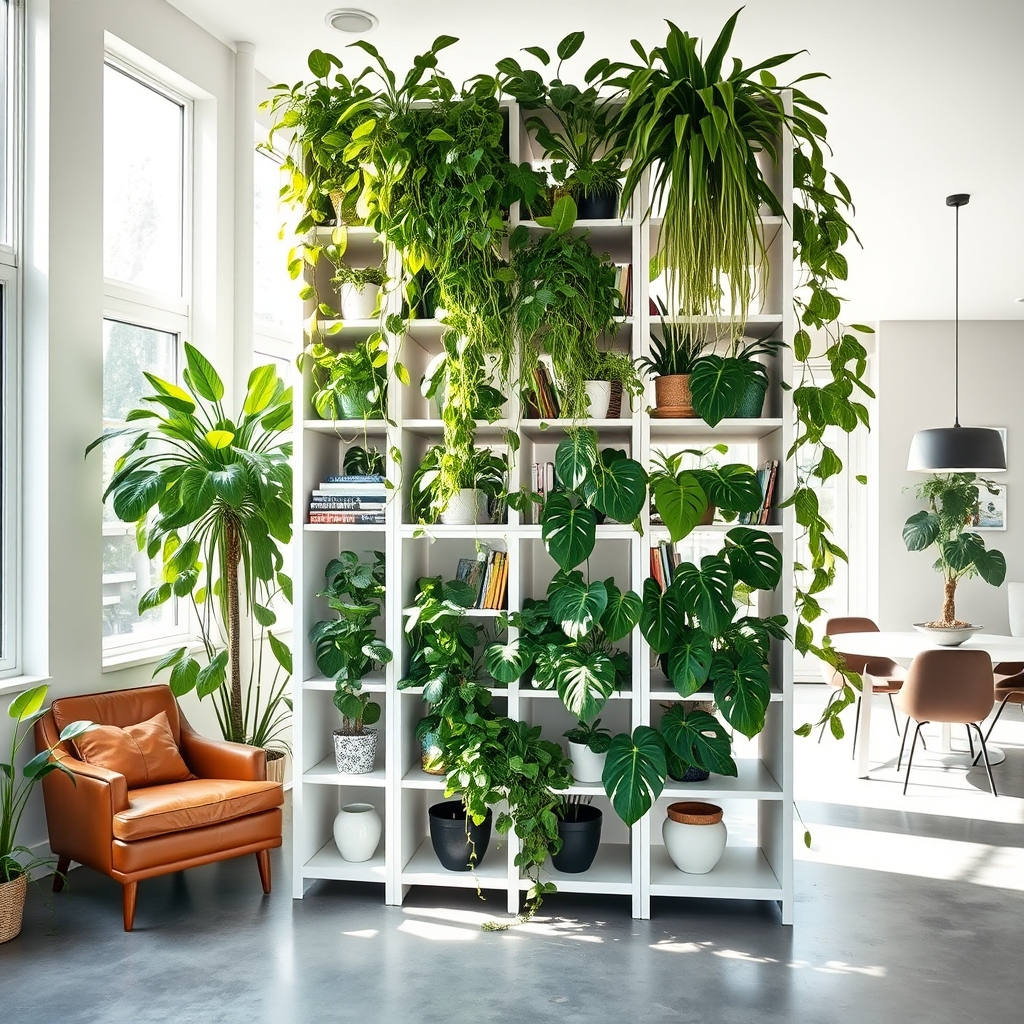
A plant-based room divider creates a natural, living separation between spaces using strategically arranged potted plants. This vertical garden solution typically consists of multiple plants at varying heights placed on shelving units, ladder stands, or modular units.
Plants can be arranged on open bookcases, macramé hangers, or dedicated plant stands to form a semi-transparent wall that maintains airflow while defining distinct areas. The unique feature of this divider is its ability to serve dual purposes – acting as both a privacy screen and a dynamic, air-purifying display that adds organic texture and life to any room.
Trailing vines, tall snake plants, or clusters of leafy specimens can be mixed to create depth and visual interest while effectively sectioning off space.
Craft a Hanging Herb Garden for Kitchen Spaces
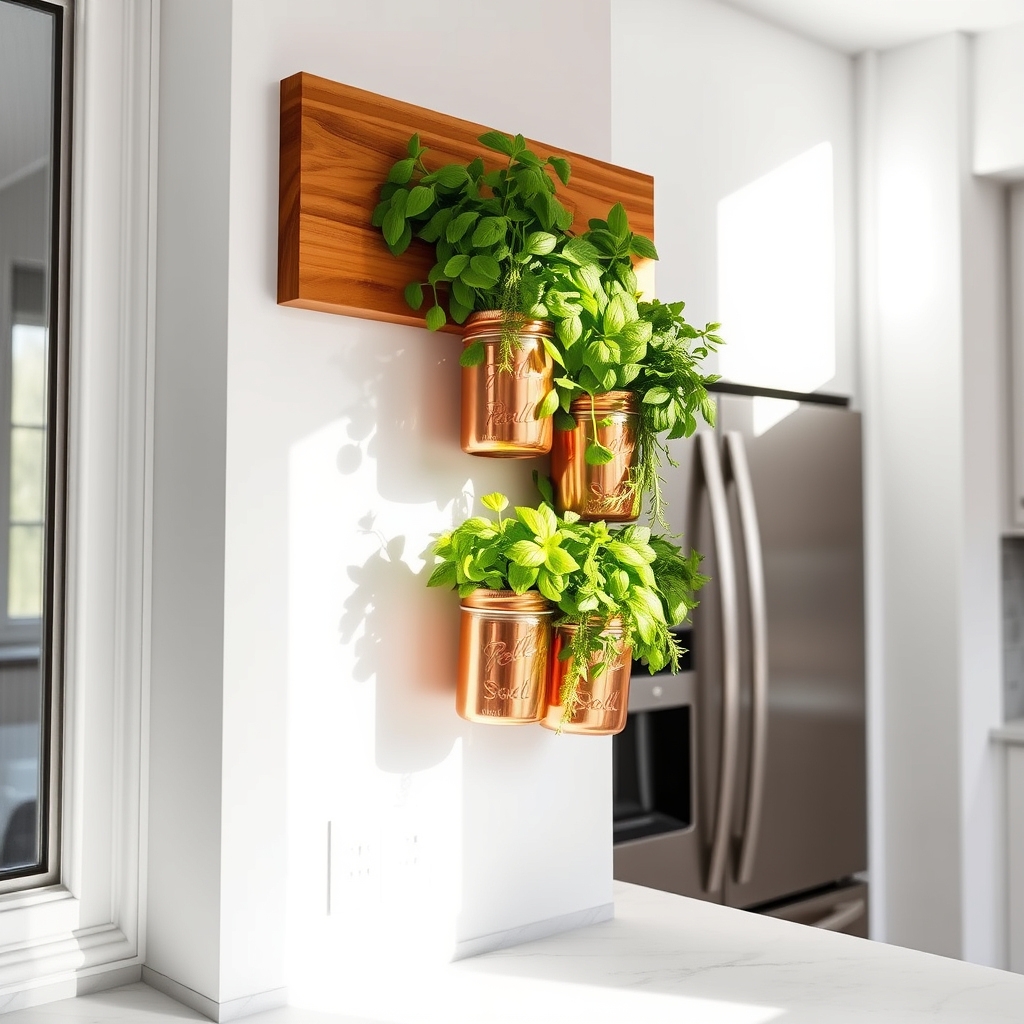
A hanging herb garden transforms kitchen spaces by utilizing vertical wall space to create a living tapestry of fresh herbs within arm’s reach.
The setup typically features tiered planters, mason jars, or repurposed containers mounted on wooden boards or metal frames, suspended from sturdy hooks or brackets.
Multiple levels of herbs cascade downward, creating a green focal point while keeping countertops clear.
Essential cooking herbs like basil, thyme, and mint grow in individual containers, making it easy to snip fresh ingredients while cooking.
The design combines functionality with aesthetic appeal, adding natural elements to kitchen decor while maximizing space efficiency in smaller areas.
Incorporate Plants Into Bathroom Décor
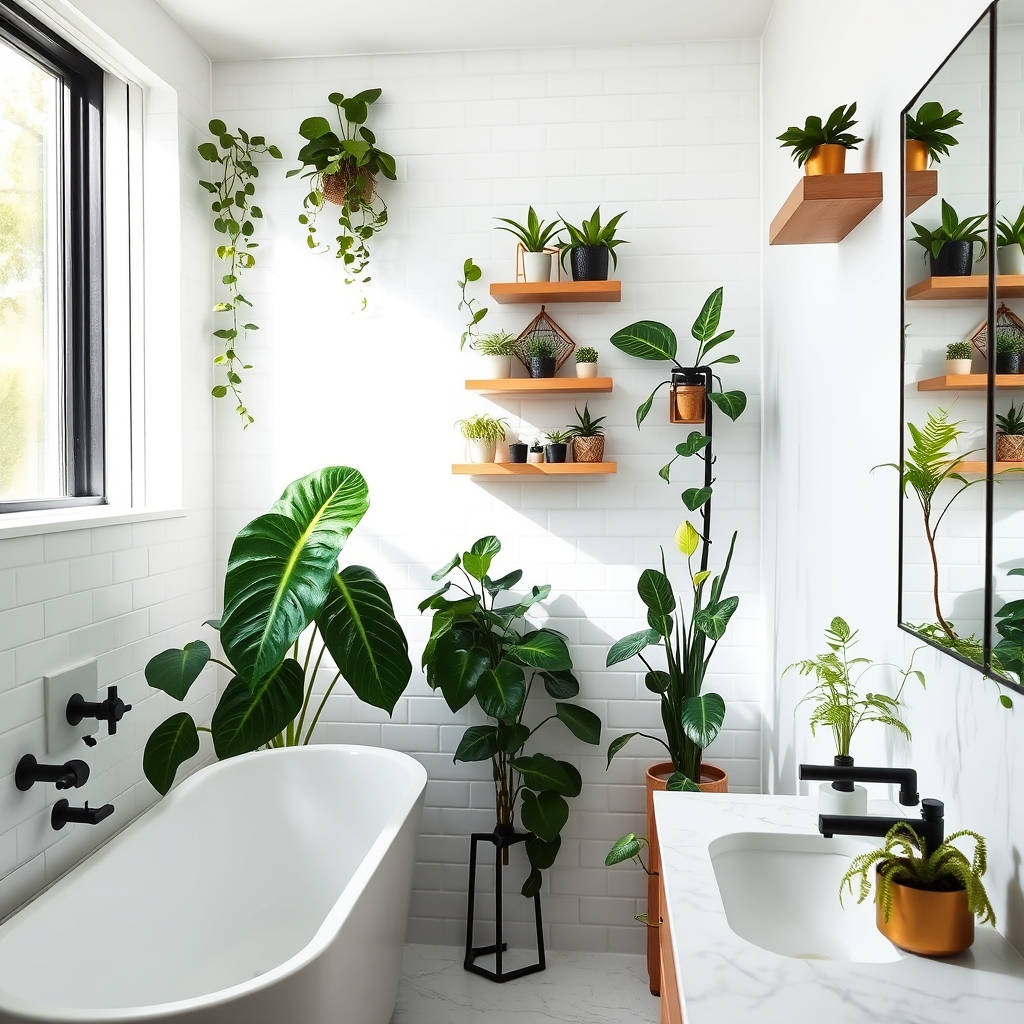
Incorporating plants into bathroom décor transforms an ordinary bathroom into a spa-like sanctuary by strategically placing moisture-loving plants on windowsills, countertops, and shower ledges.
Snake plants, pothos, and ferns thrive in humid bathroom environments, while floating shelves and hanging planters maximize vertical space. Bamboo stands or ladder shelves create stylish plant displays without consuming floor space.
Small succulents arranged near sinks add natural elements without overwhelming the space. Plants not only enhance aesthetics but also naturally purify air and absorb excess moisture, making them ideal for bathroom environments.
Choosing waterproof containers and proper drainage prevents water damage to surfaces, while selecting various plant heights and textures creates visual interest in this intimate space.
Design a Plant-Themed Workspace Oasis
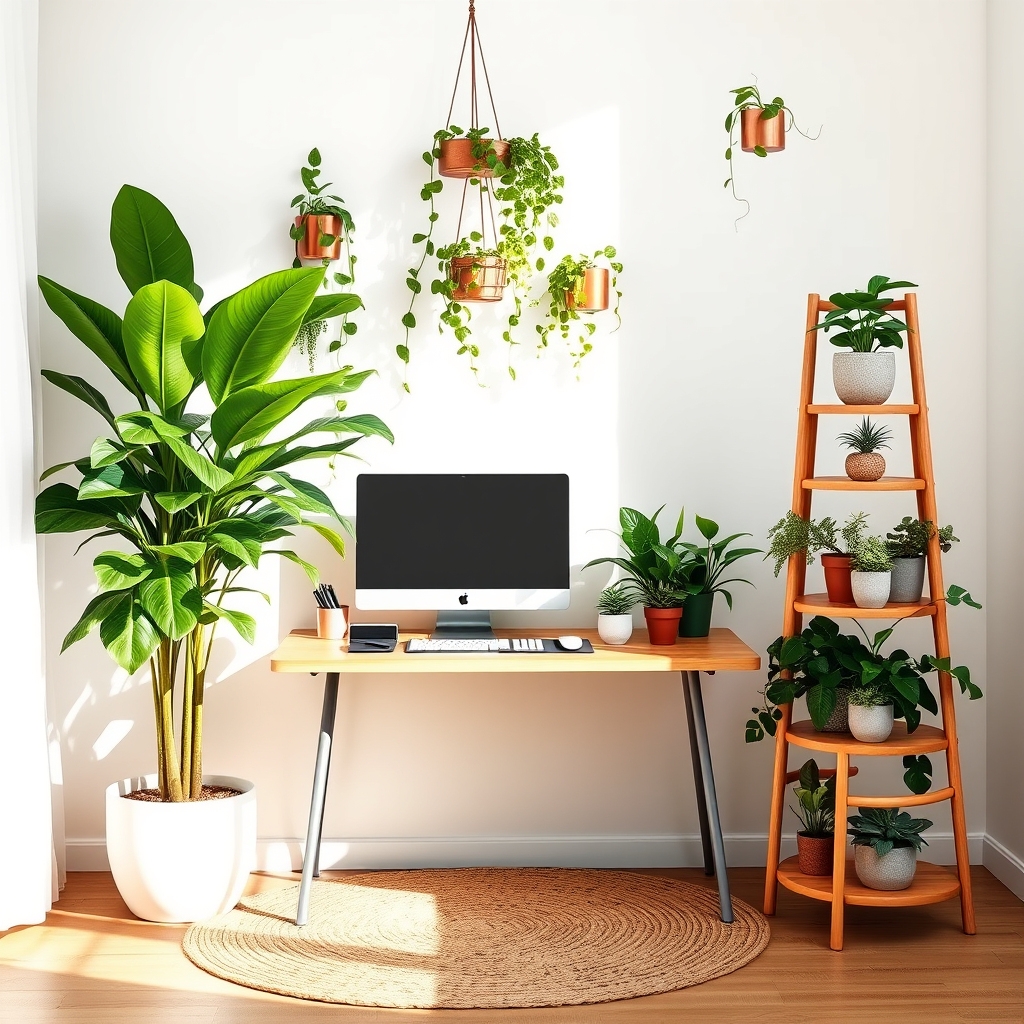
A plant-themed workspace oasis transforms a standard desk area into a lush, productive environment by strategically incorporating various indoor plants. Small succulents and air plants occupy desk corners and monitor stands, while trailing pothos or philodendrons cascade from elevated shelves or hanging planters.
A medium-sized snake plant or ZZ plant stands sentinel beside the desk, providing vertical interest and natural air purification.
The workspace features multi-level plant displays using risers, floating shelves, or tiered plant stands to maximize vertical space. Desktop accessories like pencil holders and paperweights incorporate botanical motifs, while natural materials such as bamboo or wooden organizers complement the green theme.
A dedicated plant care station houses watering tools and maintenance supplies, tucked neatly into a drawer or stylish container.
Natural light from a nearby window illuminates both work surface and plants, while supplementary grow lights ensure plant health in darker areas. The overall design creates a calming, biophilic environment that promotes focus and creativity while maintaining professional functionality.
